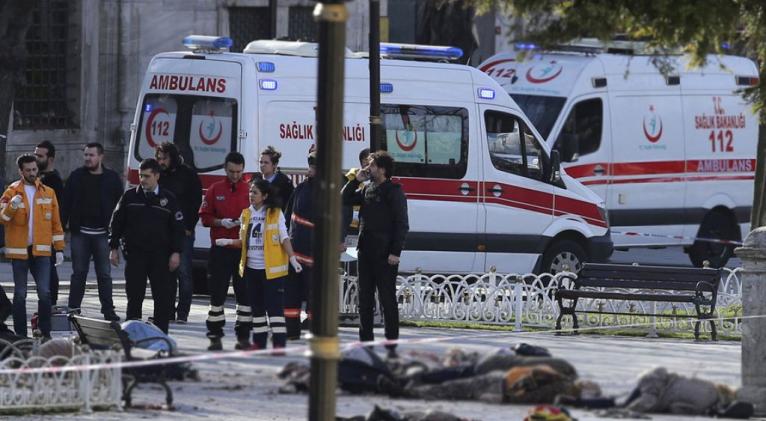At least 10 foreigners killed, 15 wounded in suicide bombing on central Istanbul square
especiales

At least nine German citizens were injured in the blast, Reuters reports citing a senior Turkish official.
One more injured is Norwegian and another one is Peruvian, according to Dogan news agency. Norway’s Foreign Ministry later confirmed that one Norwegian citizen was injured in the blast and is receiving treatment at a local hospital.
"It's not a life-threatening injury," Norwegian Foreign Ministry spokeswoman Guri Solberg said.
Peru's Foreign Ministry also confirmed that one Peruvian man was killed and a Peruvian woman wounded in the suicide bombing.
There was a group of German tourists on the square at the time of the blasts, an official from a tour company told Reuters on condition of anonymity.
The explosion took place on Sultanahmet Square. It occurred close to the Sultanahmet tram stop and Dikilitas, the Obelisk of Theodosius, in the heart of Istanbul’s tourist district.
Turkish President Recep Tayyip Erdogan said a Syrian suicide bomber is believed to be responsible for the deadly attack.
"I condemn the terror incident in Istanbul assessed to be an attack by a suicide bomber with Syrian origin. Unfortunately we have 10 dead including foreigners and Turkish nationals... There are also 15 wounded," Erdogan said.
Istanbul authorities are investigating the incident and the type of the explosives used in the blast, the governor’s office said.
The suicide bomber was identified as a Syrian born in 1988, Deputy Prime Minister Numan Kurtulmuş said during a press conference, adding that most of the victims of the blast are foreigners.
Dogan news agency later reported that the suspect had been identified as Saudi-born Nabil Fadlı. His birth year was confirmed as 1988, the agency said, citing police.
Prime Minister Ahmet Davutoğlu also said the suspect may be a member of the terror group Islamic State (formerly ISIS/ISIL). According to Turkish officials, he recently entered Turkey from Syria.
Erdem Koroglu, who was working at a nearby office at the time of the explosion, told NTV he saw several people lying on the ground following the blast.
“It was difficult to say who was alive or dead,” Koroglu said. “Buildings rattled from the force of the explosion.”
One woman who works at a nearby antiques store told Reuters that the explosion was very loud.
"We shook a lot. We ran out and saw body parts," she said.
"I started running away with my daughter. We went into a nearby building and stayed there for half an hour. It was really scary," a German tourist named Caroline told AFP.
"We're taking precautions against a second explosion," a police officer said.
Shortly after the blast, Turkish authorities slapped a media ban on covering it, Anadolu news agency said.
Sultanahmet Square, once a social center of the former Constantinople, is a popular tourist destination. A 30-meter-tall Obelisk of Theodosius made of red granite is located in the center of the square, as well as the famous German Fountain (The Kaiser Wilhelm Fountain) which was constructed by the German government back in 1900.
Another main attraction near the square is Hagia Sophia, one of the greatest surviving examples of Byzantine architecture, which draws hundreds of tourists every day.
After the explosion, the German Foreign Office issued a statement, urging its citizens to avoid public places and tourist attractions in Istanbul. The office added that it fears there is a risk of terrorist attacks across Turkey, and called on its citizens to “avoid staying near government and military institutions.”
The UK Foreign and Commonwealth Office (FCO) has also issued a travel warning for British citizens in Turkey.













Add new comment